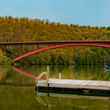Five years ago, as I gingerly walked along the gunwale of a Mexican panga while the boat sat anchored in the sand of Ascension Bay, I misjudged my footing. Had I stepped down into the boat, I would have crushed my fishing buddy’s camera gear and earned his ire for the rest of the trip … perhaps the rest of my life. He really likes his camera gear.
But I was committed. My substantial body weight was headed in that general direction. But I did have an alternative. With my left foot, I kicked out, and flopped unceremoniously into the crystal clear water of the bay.
Believe it or not, I was much more athletic back then. I spent that trip to the Yucatan standing in the front of the boat, casting to bonefish and permit. I hopped in and out of the craft to wade the flats or wander shorelines. I was … functional, despite the less-than-graceful dunk in the bay. For a middle-aged guy, I figured I was as good as could be expected.
Then it happened. My back—which hasn’t been great for years— got really old. A couple of years after that first trip to the Palometa Club, I returned to Ascension Bay, and I was so ginger in front of the panga that couldn’t step up on the casting platform with any confidence. The pain in my lower back and left leg was nearly constant, and I had to sit down more than I would normally do. My fishing buddy—he of the priceless camera fetish—noticed.
“You OK, buddy?” he asked as I cast to bonefish from the bow, but not the platform. My pain was palpable. And I hated to admit it.
More Like This
Over the last couple of years, it got worse and worse, until, last summer, while fishing for pike with my son in northern Manitoba, I could stand in the bow of the boat for only about five minutes before I had sit.
A worn-out back and nearly half a century on the planet had broken me down. I felt old. I felt useless. Something had to be done.
So I went to a surgeon. I explained the issue. We did x-rays and an MRI. He developed a plan for long-term sustainability.
“You’ll fish again,” he said. “How much or how well … well, that’s up to you.”
Earlier this winter, I had three vertebrae fused in my lower back. For those of you familiar with the bones and discs that tend to rub against the sciatic nerve and send a never-ending spark of sharp pain through your butt cheek, down your leg all the way down to your big toe, my L4, L5 and S1 are now fused together. Presently, bones are growing between the joints, and they’re getting an assist from six screws and two titanium rods.
About two days after the surgery, laying in a recovery room bed sweating and panting after a physical therapist with the patience of a Gulag warden had marched me around the hospital hallways for 30 minutes, I looked at my son who was sitting with me, and asked, “What the hell was I thinking?”
The pain associated with spasming muscles, a four-inch-long incision and the general need for nearly every movement in my body to start in my lower back (or so it seemed), I was having some serious buyer’s remorse. I could have lived with the sciatic pain the rest of my life. Five minutes in the front of the boat? On a good day, I could land three pike in those five minutes.
The spasms were brutal, adjusting myself in bed was an exercise in agony and the clock seemed to slow down as I cheered it on, just so I could take another pain pill.
My entire fly-rod collection for a morphine drip. Please.
Back then, I thought I’d made a mistake. After all, who in their right mind would believe it to be a good thing when a surgeon says, “We’ll just make a cut here, take a bone graft from your hip, fuse these bones and that’s that?”
Oh, and 10 to 12 weeks of “light duty.” Light duty sounds like dusting and vacuuming, but not windows, right? Turned out light duty meant a solid week in bed with forced marches around the basement twice a day. And when I was able to move around, it was no fun. And then, three weeks of asking for quick favors from friends and family.
“Will you take my garbage out?”
“Will you dump my dishwasher?”
“Will you fold my underwear?”
No fun. No fun at all.
Sitting at my computer to work was torture. I’d look at my fly-tying bench and think, “Maybe I can do that.” Nope. Agony.
Honestly, I began to worry that I’d never go fishing again. Hell, I would have been happy with the promise of being able to do my own damn laundry.
Last week, I donned waders for the first time in months. I’d done some light fishing over the last few weeks, but nothing strenuous. Short walks. A few casts here and there. Kiddy-pool fishing.
Then, as I gingerly picked my way down a hillside to hit the Gibbon River with a buddy of mine, I knew this was going to be a real test. Downed logs. Boulders. A stiff, run-off encouraged current. And I’d have to walk a ways to find decent water. This was big-boy fly fishing.
I started slow. I found a deep run, tied on a weighted Slumpbuster and just started swinging. The Gibbon is a solid trout stream in the spring and early summer, and we’d hit it just about right. The foot-long browns that make up the bulk of the river’s trout population were cooperative, and I managed to land a nice one within just a few minutes.
But, being the dilittente angler that I am, I felt the urge to reach new water. I stepped into the swift current of the river, and pushed against the water until I was standing in the Gibbon up to my thighs. It felt good to have the cold water push around my legs, and it felt even better to throw more line across the river and swing a streamer for hungry trout.
After a time, the desire to fish outweighed the caution I’d employed to protect my recovering back during the endeavor. I began to put to use some of the subtle “athleticism” I used to possess in greater volume. I moved through the river with confidence. My footing was good. My balance returned.
After a time, I forgot about the bones busy fusing in my lower back, and focused more on the fish in the Gibbon. I climbed over downed timber—remnants of the great fire in 1988. I stood atop a mishmash of logs and rock to reach a pool where I knew a hungry brown would take my Stimulator, and I was rewarded by the effort with a gorgeous dry-fly trout.
Before I knew it, was deep in the Gibbon River Canyon—I’d walked almost a mile up the river, to where, hundreds of feet above me, tourists took in the view of Gibbon Falls, which gushed over granite and basalt upstream of me and still out of view around a bend in the river. Here, the river has more character. Pocket water. Deep pools. Slower more deliberate runs. It’s fishy.
And the back? For a time, I forgot about the injury that, for years, has defined my ability—or lack of it—to stand in the bows of boats, or wander stream banks … or vacuum my carpet. I felt almost … normal.
And when I got back to where I’d left my fishing buddy, Dennis, I noticed that I wasn’t feeling the near-constant pressure from the muscles around the incision. I was hot and sweaty in my waders, and I was a bit winded, but I wasn’t hurting.
As we sat on the National Park Service picnic bench overlooking the river, an ice-cold beer tasted damn sweet.
It’s been five months since the surgery, and it was a long, dreary winter. That I spent it largely laid up and in a certain amount of suspense surely didn’t help. But healing takes time. More time that I would certainly have thought.
The buyer’s remorse is gone. Hope had been restored. The doubt over my decision to allow a surgeon to slice into my back subsided.
I could, indeed, go fishing again. It’s going to be a great summer.

































Comments